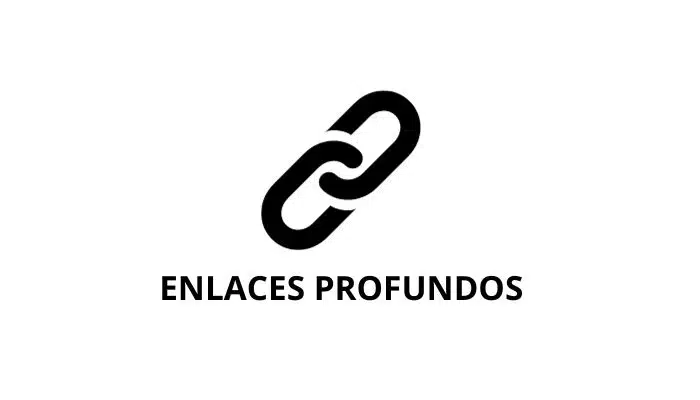In today’s dynamic digital landscape, navigation efficiency becomes crucial. Deep Linking represents an innovative methodology that allows users to directly access specific pages in applications or websites, transforming the browsing experience significantly.
It’s not just about simplifying interaction, it’s about personalizing every user experience. Join us in this article as we explore in detail the intriguing concept of deep linking, an essential tool for optimizing navigation and enriching digital interaction. Embark on this fascinating journey of discovery in the digital world!
What is a Deep Link?
A deep link, or deep link, is a URL that directs directly to specific content within a mobile app or website, rather than simply opening the app or home page.
These links allow users to directly and quickly access specific functions, pages or sections, improving the browsing experience and facilitating interaction with the desired content.
Deep links are essential to personalize the user experience, optimize marketing campaigns and simplify navigation in the digital environment.
Types of Deep Links
There are several types of deep links, each designed to fulfill specific functions within mobile applications or websites. Here are some of the most common types:
- Basic Deep Links (Traditional Deep Links):Direct users to a specific screen within a mobile application.
- Fragmented Deep Links (Fragment Deep Links):They work for Android applications, directing users to a specific fragment within a screen.
- Deep Action Links:Initiate a specific action in an application, such as playing a song or adding an item to the shopping cart.
- Deep Navigation Links:They help guide users through the navigation of the application, allowing for a smooth experience.
- Deep Return Links:Redirect users to the application after they have left it, maintaining the context.
- Universal Deep Links (Universal Deep Links):They work on multiple platforms, being valid for both iOS and Android.
- Contextual Deep Links (Contextual Deep Links):They adapt the user experience according to the context, offering personalized content.
- Redirect Deep Links:They direct users through a series of redirects before reaching the final content.
- Search deep links (Search deep links):Allow users to perform specific searches within an application.
- Deep Invitation Links:Facilitates inviting users to download an application or join a specific feature.
These types of deep links adapt to various needs, improving accessibility and interaction in the digital environment.
Benefits of Deep Link
The implementation of deep links offers a number of significant benefits for users, developers and enterprises alike. Here are some of the key benefits:
1. Improved user experience
- Deep links allow users to directly access relevant content, improving the browsing experience and reducing search time.
2. Increased retention
- By directing users to specific functions within an application, retention is encouraged as they quickly find what they are looking for.
Improved platform interconnection
- Universal deep links work across multiple platforms, easing the transition between applications and mobile platforms.
4. Promotion of specific content
- They facilitate the promotion of specific content, enabling more effective and personalized marketing campaigns.
5. Optimization of advertising campaigns:
- By using deep links in advertising campaigns, you can direct users directly to specific products or promotions, improving conversion rates.
6. Improved tracking and analytics:
- Deep links provide more detailed data on user behavior, allowing for more precise analysis and strategy optimization.
7. Reactivation of users:
- With deep backlinks, you can redirect specific users back to the application, saving them relevant content and reactivating them.
8. Facilitate integration with external platforms:
- Enables easier integration with external services and platforms, such as links from emails or messages.
9. Greater flexibility in marketing strategies:
- It provides marketers with a flexible tool to create more targeted and personalized campaigns.
10. Increased efficiency in development:
- Developers can create a more fluid and targeted user experience without the need for complex navigation paths.
How to make a Deep Link correctly?
The creation of a Deep Link requires a careful approach to ensure its correct implementation and functionality. Here is a step-by-step guide on how to deep link correctly:
1. Identify the Target Content:
- Clearly define what specific content you want to link. It can be a screen, product, item or any specific element within your application.
2. Use the correct URL scheme:
- Each application has a unique URL scheme that defines how it is accessed through a link. Make sure you know the URL scheme of your application.
3. Configure the deep link in the application:
- Implement deep link handling in your application code. This is usually done in the Android manifest file or the iOS URL property file.
Generates Universal Deep Links:
- If possible, use universal deep links that work on multiple platforms (iOS and Android). This simplifies marketing campaigns and improves the user experience.
4. Integrate Custom Parameters (Optional):
- You can add custom parameters to the deep link to provide additional information. This can be useful for targeted tracking or personalizing the user experience.
5. Testing on Real Devices:
- Before implementing deep links in your campaigns, perform extensive testing on real devices to ensure that the redirect works properly.
6. Manages Non-Application Scenarios:
- If a user clicks on a deep link and does not have the app installed, be sure to handle this gracefully, either by redirecting them to the appropriate app store or to a web page.
7. Integrate with Analytics Platforms:
- Set up integration with analytics platforms to track the performance of your deep links and gain valuable insights into user behavior.
8. Maintain Consistency in Campaigns:
- Use deep links consistently in all your marketing campaigns to avoid confusion and ensure a uniform experience for users.
9. Update regularly:
- As your application evolves, update the deep links as necessary to reflect changes in the structure and content of the application.
By following these steps, you will be able to effectively create and manage deep links that improve accessibility and user experience in your application.
How to make this strategy effective?
To ensure that your Deep Link strategy is effective, it is essential to implement the following practices:
Strategic planning
Before implementing deep linking, perform strategic planning. Clearly define the goals you want to achieve with deep links, whether it’s increasing user retention, improving conversions or personalizing the user experience.
2. Understand your audience
Know your audience and their behaviors. This will help you create deep links that are relevant and attractive to them. Customize deep links according to the preferences and needs of your users.
3. Search Engine Optimization
Make sure your deep links are optimized for search engines. Use clear and relevant descriptions and specific keywords that help search engines understand the linked content.
4. Integration with marketing campaigns
Incorporate deep linking into your marketing campaigns. This may include emails, social media postings and other strategies. Make sure the call to action is clear and leads to a seamless experience.
5. Follow-up and analytics
Implement tracking and analysis tools to evaluate the performance of your deep links. Analyze metrics such as click-through rates, conversions and user behavior. Use this data to make adjustments and continuous improvements.
6. Offer personalized content
Use deep links to direct users to personalized content. This may include exclusive offers, personalized recommendations or any other content that enhances the user experience and encourages engagement.
7. Guarantee a continuous experience:
Make sure the user experience is consistent from the deep link to the application. It avoids unnecessary redirects and provides the expected information or functionality.
8. A/B Testing
Perform A/B testing with different deep links to understand which approaches are most effective. Experiment with calls to action, descriptions and destinations to continually optimize your strategy.
9. Upgrades and maintenance
Keep your deep links updated with application or content changes. Ensure that links are not broken and that they continue to provide value as your application evolves.
10. Promotion of the application
Incorporate deep links into your overall application promotion efforts. Give users direct access to specific functions or relevant content from your promotional campaigns.
The strategic implementation of deep linking not only improves accessibility to specific functions within an application, but also enhances the user experience. By understanding individual preferences, optimizing for search engines and offering personalized content, brands can strengthen the connection with their audience.
If you need help, in Kiwop we will always be there for you. Do not hesitate to contact us!



Leave a Reply